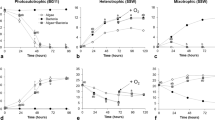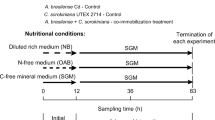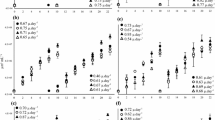Abstract
Competition experiments between Chromatium vinosum and Chlorobium limicola in sulfide-limited continuous culture under photolithoautotrophic conditions resulted in the coexistence of both organisms. The ratio between the two bacteria was dilution-rate as well as pH dependent. The observed coexistence can be explained as a hitherto not reported form of dual substrate limitation. The two substrates involved are the electron donors sulfide (growth-limiting substrate in the reservoir vessel) and extracellular elemental sulfur (formed by Chlorobium as a result of sulfide oxidation). It is argued that, although Chlorobium may have the better affinity for both substrates involved, Chromatium can compete successfully on the basis of its intracellular storage of sulfur. Ecological implication of the observed coexistence with respect to natural blooms are discussed.
Similar content being viewed by others
Abbreviations
- Bchl:
-
bacteriochlorophyll
- me:
-
milliequivalent
- D:
-
dilution rate
References
Anagnostidis, K, Overbeck J (1966) Methanoxydierer und hypolimnische Schwefelbakterien. Studien zur ökologischen Biocönotik der Gewässermikroorganismen. Ber Deutsch Bot Ges 79:163–174
Beeftink HH, van Gemerden H (1979) Actual and potential rates of substrate oxidation and product formation in continous cultures of Chromatium vinosum. Arch Microbiol 121:161–167
Biebl H, Pfennig N (1978) Growth yields of green sulfur bacteria in mixed cultures with sulfur and sulfate reducing bacteria. Arch Microbiol 117:9–19
Cohen Y, Krumbein WE, Shilo M (1977) Solar Lake (Sinai). 2. Distribution of photosynthetic microorganisms and primary production. Limnol Oceanogr 22:609–620
Cohen-Bazire G, Sistrom WR, Stanier RY (1957) Kinetic studies of pigment synthesis by purple non-sulfur bacteria. J Cell Comp Physiol 49:25–68
Culver DA, Brunskill GJ (1969) Fayetteville Green Lake, New York. V. Studies of primary production and zooplankton in a meromictic marl lake. Limnol Oceanogr 14:862–873
Fredrickson AG (1977) Behaviour of mixed cultures of microorganisms. Ann Rev Microbiol 31:63–87
Gorlenko VM, Chebatarev EN, Kachalkin VI (1975) Participation of microorganisms in the circulation of sulfur in Pomyaretskoe Lake. Microbiology 43:772–776
Guerrero R, Abella C (1978) Dynámica espaciotemporal de las poblationas bacteriahas fotosynthéticas en una laguna anaerobia de aguas sulfurosas. Oecol Aquatica 3:193–205
Herbert D, Phipps PJ, Strange RE (1971) Chemical analysis of microbial cells. In: Norris JR, Ribbons DW (eds) Methods in microbiology, vol 5B. Academic Press, New York, pp 209–344
Lowry OH, Rosebrough NJ, Farr AL, Randall RJ (1951) Protein measurement with the Folin phenol reagent. J Biol Chem 193:265–275
Olson JM, Romano CA (1962) A new chlorophyll from green bacteria. Biochim Biophys Acta 59:726–728
Takahashi M, Ichimura KS (1970) Photosynthetic properties and growth of photosynthetic sulfur bacteria in lakes. Limmol Oceanogr 15:929–944
Thiele HH (1968) Die Verwertung einfacher organischer Substrate durch Thiorhodaceae. Arch Mikrobiol 60:124–138
Trüper HG, Genovese S (1968) Characterization of photosynthetic sulfur bacteria causing red water in Lake Faro (Messina, Sicily). Limnol Oceanogr 13:225–232
Van Gemerden H (1974) Coexistence of organisms competing for the same substrate: an example among the purple sulfur bacteria. Micr Ecol 1:104–119
Van Gemerden H, Beeftink HH (1978) Specific rates of substrate oxidation and product formation in autotrophically growing cultures of Chromatium vinosum. Arch Microbiol 119:135–143
Van Niel CB (1963) A brief survey of the photosynthetic bacteria. In: Gest H, San Pietro A, Vernon LP (eds) Bacterial photosynthesis. The Antioch Press, Yellow Springs, pp 459–467
Author information
Authors and Affiliations
Rights and permissions
About this article
Cite this article
van Gemerden, H., Beeftink, H.H. Coexistence of Chlorobium and Chromatium in a sulfide-limited continuous culture. Arch. Microbiol. 129, 32–34 (1981). https://doi.org/10.1007/BF00417175
Received:
Accepted:
Issue Date:
DOI: https://doi.org/10.1007/BF00417175




